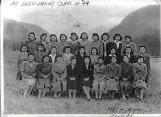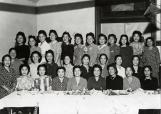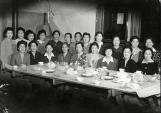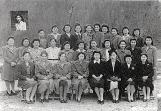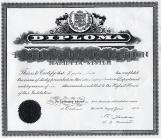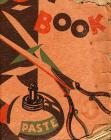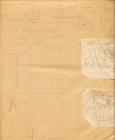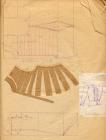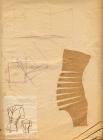1
Sewing in internment and exileWhen Japanese Canadians were forced to relocate 100 miles from the Pacific coast in 1942, all the dressmaking businesses they owned in Vancouver were closed. Few were able to sell -- many were forced to close and just leave their shops behind.
In the internment camps in the interior of British Columbia, sewing and dressmaking were important ways of coping with scant resources and harsh conditions. With few options available to purchase clothing, garments were fashioned from stockpiled fabric, reused material, or bolts ordered through the catalogue. In almost all the camps, dressmaking classes and schools were re-established and were once again very popular.
At the end of the war, Japanese Canadians were faced with a second uprooting and prohibited from returning home to the Pacific Coast. For many Japanese Canadian women forced to choose between relocating east of the Rockies or moving to Japan, dressmaking became an invaluable means of survival and a livelihood. For those who went to Japan in 1946, dressmaking Canadian-style was one familiar means of identifying with their land of birth -- Canada -- during exile.
3
Chizuko Yasui (nee Sora) recalls Bay Farm Sewing ClubMrs. Yano, who came from Duncan on Vancouver Island, taught a few of us at Bay Farm. She'd hold classes in her home, and we'd go to learn how to sew between shifts at the hospital. A table was set up in the middle of the room, and she'd lay out fabric and teach us how to cut a pattern. She had her own sewing machine. Our family also had a sewing machine. Many families in Bay Farm had sewing machines. Before the evacuation [in Cumberland, BC], my mom sewed all of our clothes, so we must have brought our sewing machine with us. We learned how to cut a pattern, and then we'd take it home and sew parts of the pattern, and then bring it back for the next class.
The reason we went to these sewing classes was to learn how to sew our own clothes. We were young and wanted a change of clothes, and buying clothes was too expensive. There were no clothing stores around, but even if there were, we couldn't afford to buy them. We hardly made any money [at the hospital], about thirty-five cents an hour. So, we had to make everything ourselves. We'd grow our own food and sew clothes. Many women sewed for their families and themselves.
I think Mrs. Yano went back to the coast after the war [in 1949], but I don't know where she went. Maybe back to Duncan. I'm sure all her kids are grown up. I would sure like to know what happened to her.
5
Chie OyaChie Oya learned how to make kimonos and sewed for kimono shops in Japan between 1934 and 1937. She arrived in Canada with her first child to join her husband in 1940. In 1942, Chie, her husband and her children were interned at Slocan City.
"... Mrs. Muraki was asked to teach dressmaking classes. We gave a token fee of $2.00 per month ... We all had sewing machines. They were set up in 'Building No. 1.' I went to school 5 days/week. I was unable to find a babysitter, so I brought my young children with me to play outside of the school building and many women didn't like that. I guess the kids were too noisy.
... I was able to sew an outfit, pants and shirt, for my young son for 35¢. Four yards of material costed $1.00."
After the war, the Oyas relocated to Japan. Chie recalls:
"I was able to add to the family income by sewing. Western clothing was in demand. Through word of mouth, people came to me to ask for clothing to be made. I had about 5 families that I sewed for, and they introduced me to more people.
... I was sewing every day ... whenever I had spare time in between housework and cooking ... I could sew 2 skirts per day. My two young daughters who were in grade 4 and 5, helped with the hemming. I sewed until 1 or 2 o'clock in the morning. My eyes became so tired ... I think I charged about 100 yen per skirt and at that time, the average wage, I think, was about 2000 yen per month ... You could make money by sewing, but boy was it hard work and long, long hours."
From a conversation with Naomi Sawada, Japanese Canadian National Museum, and Emiko Sawada, translator, June 1996.
7
Dressmaking class portrait, Tashme, BC, May 1944. Mary Fumiko Ikeda Otto Collection, JCNM.May, 1944
Tashme, BC
